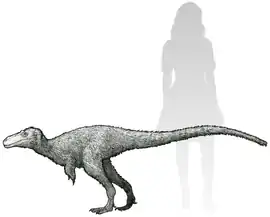Souvrství Moreno Hill
Souvrství Moreno Hill je geologickou formací na území státu Nové Mexiko v USA. Stáří sedimentů činí asi 91 až 88 milionů let, jedná se tedy o usazeniny z počátku pozdní křídy (geologický stupeň turon až coniak).[1] Souvrství bylo oficiálně definováno v roce 1983 a pojmenováno podle sedimentárních výchozů v oblasti Moreno Hills v uhelných polích Salt Lake na západě Nového Mexika.[2]
.jpg.webp)
Nothronychus, jeden z dinosaurů, objevených v souvrství Moreno Hill.
Charakteristika
Nejběžnější horninou v tomto souvrství je pískovec, méně zastoupen je jílovec, prachovec a uhlí. Nejvyšší mocnost sedimentů tohoto souvrství činí 217 metrů. Původně se předpokládalo, že zde nejsou žádné fosilie obratlovců, dnes už ale odtud známe několik druhů dinosaurů[3] a také ryby a další obratlovce.[4][5]
Dinosauří fauna

Suskityrannus - rekonstrukce vzezření
- Nothronychus mckinleyi - therizinosauroid[7]
- Suskityrannus hazelae - tyranosauroid[8]
- Zuniceratops christopheri - ceratopsoid[9]
- Ankylosauria indet. - fosilní zuby[10]
Odkazy
Reference
- Charl D. Cilliers, Ryan T. Tucker, James L. Crowley & Lindsay E. Zanno (2021). Age constraint for the Moreno Hill Formation (Zuni Basin) by CA-TIMS and LA-ICP-MS detrital zircon geochronology. PeerJ. 9: e10948. doi: https://doi.org/10.7717/peerj.10948
- McLellan, M. W.; Haschke, L. R.; Robinson, L. N.; Carter, M. D.; Medlin, A. L. (1983). Middle Turonian and younger Cretaceous rocks, northern Salt Lake coal field, Cibola and Catron Counties, New Mexico (PDF). New Mexico Bureau of Mines and Mineral Resources Circular. 185: 41–47.
- SOCHA, Vladimír. Lenivý dráp vnímající infrazvuk. OSEL.cz [online]. 18. února 2021. Dostupné online. (česky)
- Weishampel, David B; et al. (2004). Dinosaur distribution (Late Cretaceous, North America). In: Weishampel, David B.; Dodson, Peter; and Osmólska, Halszka (eds.): The Dinosauria, 2nd Edition. Berkeley: University of California Press. Pp. 574-588. ISBN 0-520-24209-2.
- https://blog.everythingdinosaur.co.uk/blog/_archives/2019/05/06
- McDonald, A. T.; Wolfe, D. G.; Kirkland, J. I. (2006). On a hadrosauromorph (Dinosauria: Onithopoda) from the Moreno Hill Formation (Cretaceous, Turonian) of New Mexico. New Mexico Museum of Natural History and Science Bulletin. 35: 277–280.
- Kirkland, J. I.; Wolfe, D. G. (2001). First definitive therizinosaurid (Dinosauria: Theropoda) from North America. Journal of Vertebrate Paleontology. 21 (3): 410–414.
- Nesbitt, Sterling J.; et al. (2019). A mid-Cretaceous tyrannosauroid and the origin of North American end-Cretaceous dinosaur assemblages. Nature Ecology & Evolution. 3 (6): 892–899.
- Wolfe, D. G.; Kirkland, J. I. (1998). Zuniceratops christopheri n. gen. & n. sp., a ceratopsian dinosaur from the Moreno Hill Formation (Cretaceous, Turonian) of west-central New Mexico. New Mexico Museum of Natural History and Science, Bulletin. 14: 303–317.
- Sterling J. Nesbitt; et al. (2019). Supplementary information for: A mid-Cretaceous tyrannosauroid and the origin of North American end-Cretaceous dinosaur assemblages (PDF). Nature Ecology & Evolution. 3 (6): 892–899.
Literatura
- Wolfe, D. G. (2000). New information on the skull of Zuniceratops christopheri, a neoceratopsian dinosaur from the Cretaceous Moreno Hill Formation, New Mexico. pp. 93–94, in S. G. Lucas and A. B. Heckert, eds. Dinosaurs of New Mexico. New Mexico Museum of Natural History and Science Bulletin. 17.
Externí odkazy
- SOCHA, Vladimír. Tyranský kojot. OSEL.cz [online]. 10. května 2019. Dostupné online. (česky)
Portály: Dinosauři | Spojené státy americké
This article is issued from Wikipedia. The text is licensed under Creative Commons - Attribution - Sharealike. Additional terms may apply for the media files.